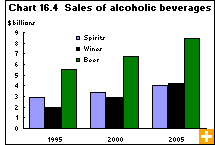Common menu bar links
More Canadians choosing wine
Archived Content
Information identified as archived is provided for reference, research or recordkeeping purposes. It is not subject to the Government of Canada Web Standards and has not been altered or updated since it was archived. Please contact us to request a format other than those available.
Beer is by far the bestselling alcoholic beverage in Canada—$8.4 billion in sales or just more than half of all alcohol sold. But for the first time ever wine overtook spirits as the second bestseller in 2004/2005. Spirits and wine each account for about one-quarter of all alcohol sold.
Changing Canadian tastes are reflected in the growth of wine sales, which have consistently grown faster than those of beer and spirits in recent years. Wine sales rose 6.5% in 2004/2005 from the previous year, about twice the growth rate for beer and nearly three times that for spirits. Wine sales have grown at an annual average rate of 8.0% over the past decade.
Canadians also like sampling what the world has to offer and are increasingly buying imported drinks. Imported brands continue to expand their share of sales in Canada, capturing 34% market share in 2004/2005, compared to 22% a decade earlier. Domestic brands—particularly in the beer market—have seen much slower sales growth than imported brands.
Canadians often purchase their alcohol at a government outlet. Government regulates the sale of alcohol in most provinces and territories. In 2004/2005, Canada’s beer and liquor stores and agencies sold $16.8 billion worth of alcohol to consumers, bars, restaurants and other establishments.
Provincial and territorial liquor authorities collectively posted net income of $4.5 billion in 2004/2005. Net income increased most in British Columbia, 7.1%, and in Ontario, 6.7%. A three-month strike at Quebec’s liquor authority resulted in a 4.4% decline there.



